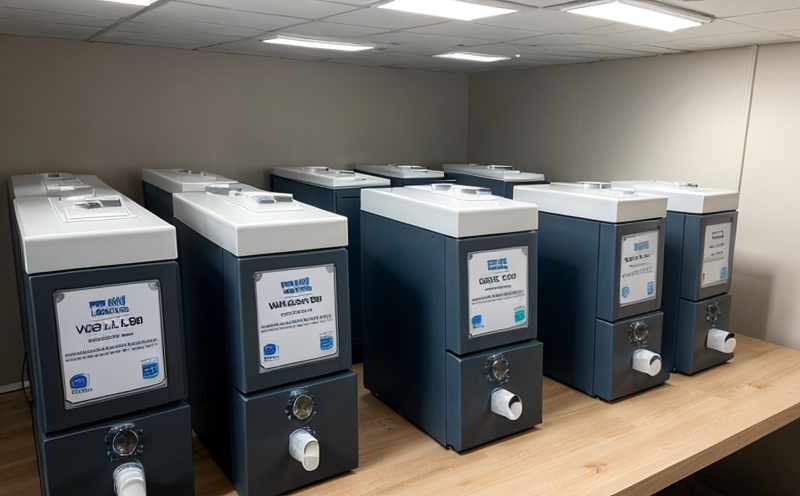ISO 14184-2 Textiles Determination of formaldehyde Vapour absorption method
The ISO 14184-2 standard is a critical tool for textile manufacturers and quality managers to assess the formaldehyde content in textiles. This method is particularly important because formaldehyde, when present at high levels, can pose health risks such as respiratory issues or skin irritation. The vapour absorption method provides an accurate quantification of formaldehyde released by textiles under specified conditions.
The procedure involves placing textile samples inside a climate-controlled chamber and exposing them to a known concentration of air. Formaldehyde in the sample's vapor phase is absorbed into a solution, which is then analyzed using colorimetric or titrimetric methods. This approach ensures that any formaldehyde present in the sample can be accurately measured.
The ISO 14184-2 standard specifies several key parameters to ensure accurate and reproducible results:
- Sample preparation: Samples must be cut into specific dimensions and conditioned for a set period before testing.
- Chamber conditions: The chamber temperature, humidity, and airflow rate are strictly controlled to ensure consistent test conditions.
- Solution selection: A suitable absorbent solution is used to capture the formaldehyde vapor released by the sample.
- Analytical methods: Colorimetric or titrimetric techniques are employed to quantify the absorbed formaldehyde in the solution.
By adhering to these stringent guidelines, laboratories can provide reliable and consistent results that help manufacturers comply with international standards. This method is widely used across various sectors, including clothing manufacturing, home textiles, and industrial fabrics, ensuring consumer safety and regulatory compliance.
The ISO 14184-2 standard also emphasizes the importance of sample preparation, which involves conditioning the samples to simulate real-world usage conditions. Conditioning helps in stabilizing the moisture content of the samples, ensuring that the released formaldehyde is representative of the actual exposure. The standard recommends a specific relative humidity and temperature for this purpose.
The absorption method allows for both quantitative and qualitative analysis. Quantitative results provide an accurate measure of the formaldehyde release, while qualitative tests can indicate whether formaldehyde is present in the sample at all. These insights are invaluable for quality managers and R&D engineers who need to ensure that their products meet strict regulatory requirements.
The ISO 14184-2 method has been widely adopted by laboratories around the world due to its reliability and accuracy. It ensures that textile manufacturers can produce safe products while minimizing potential health risks associated with formaldehyde exposure. This method is particularly crucial for industries such as clothing, bedding, and soft furnishings where prolonged contact with textiles is common.
By adhering to this standard, laboratories can provide data that is both precise and actionable, helping companies make informed decisions about their product development and safety protocols. The ISO 14184-2 method ensures that textile products are not only compliant with international standards but also safe for end-users.
Applied Standards
The ISO 14184-2 standard aligns closely with other relevant international standards, including ISO 17950 and EN 13938. These standards collectively provide a comprehensive framework for the determination of formaldehyde in textiles:
- ISO 17950: This standard provides guidelines for sampling and preparation of textile materials before testing.
- EN 13938: This European standard specifies methods for determining the free and total formaldehyde content in textile products.
The combination of these standards ensures a robust and consistent approach to formaldehyde testing, providing manufacturers with reliable data that can be used to meet regulatory requirements worldwide. Laboratories equipped to perform ISO 14184-2 tests are well-positioned to support industries that need to ensure the safety and compliance of their textile products.
Industry Applications
The ISO 14184-2 vapor absorption method finds widespread application across various sectors, including clothing manufacturing, home textiles, industrial fabrics, and medical textiles. Here are some specific applications:
- Clothing manufacturers: Ensuring that garments meet formaldehyde emission limits set by regulatory bodies like Oeko-Tex.
- Home textile producers: Guaranteeing the safety of bedding and upholstered furniture.
- Industrial fabric suppliers: Meeting industry-specific standards for workwear and protective clothing.
- Medical device manufacturers: Ensuring that medical textiles do not release harmful levels of formaldehyde during use.
In each case, the vapor absorption method helps ensure that textile products are safe for their intended users. By adhering to this standard, industries can maintain a high level of product safety and compliance with international regulations.
International Acceptance and Recognition
The ISO 14184-2 vapor absorption method is globally recognized as a reliable means for determining formaldehyde emissions from textiles. Its widespread adoption has made it an essential tool for laboratories around the world. Many countries have incorporated this standard into their national regulations, ensuring that textile products meet international safety standards.
Regulatory bodies such as the European Union's Oeko-Tex and the United States' Consumer Product Safety Commission (CPSC) rely on ISO 14184-2 to ensure that textiles do not pose health risks. Laboratories equipped with this method have the capability to provide data that meets these stringent requirements, thereby gaining international credibility.
The standard's global acceptance is further enhanced by its compatibility with other relevant standards such as ISO 17950 and EN 13938. This interoperability ensures that laboratories can offer consistent results across different regions and regulatory frameworks.





